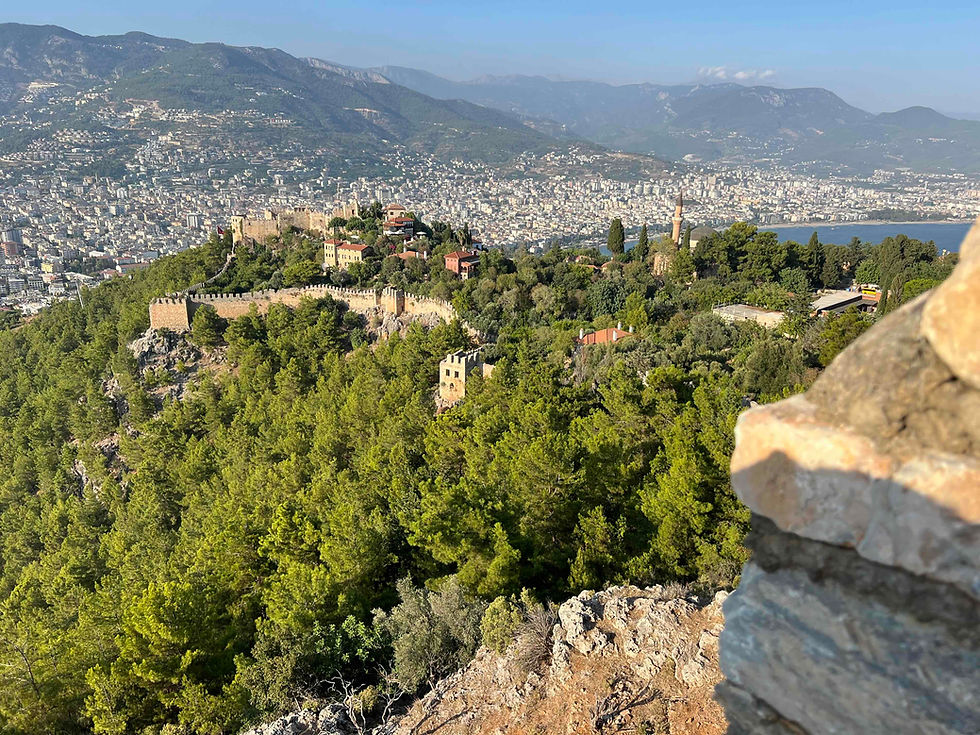
The Northern Part of the Seljuk Fortress viewed from the Citadel - Alanya at the Back
Second day in Alanya. We are waiting for the next group of sailors, mostly land lubbers from Switzerland. The captain is busy with finding prosecco now that we taught his staff to make Aperol Spritz. The deck hands replenish the ship with bottled water, fresh veggies, fish and meats. Everybody is busy. Time to go for a second stroll to Alanya’s citadel which is praised in many books as an example of Seljuk architecture.

The Turkish Seljuks united Central Asia, Persia, Mesopotamia, the Levant and Anatolia
Just to recap: The Seljuk beat the Byzantine army in Manzikert (eastern Turkey) in 1071, then slowly migrated west into Anatolia. As nomadic people from central Asia, they had not much interest in town dwelling and preferred to live in small villages and yurts. The Anatolian platform suited their nomadic lifestyle perfectly. Even today, there are a few tribes left in Türkiye who will not give up their nomadic lifes. The Seljuks advanced slowly through Anatolia. They arrived only in 1221 in Alanya. Seljuk rule was terminated by the Mongols who run Anatolia from 1243 to 1335. Only when they returned home could the tribe of Osman establish its power.

Door of a Seljuk Mosque in Persia decorated in their typical Style - Aspiring & Up-lifting
The Seljuks are well known for their contribution to architecture even though most of them lived in yurts and moved around with their cattle and horses. But under their rule, a new architectural style not seen before developed in Persia and Central Asia. It had a spirituality which mirrored the Gothic style. Not sure whether they knew about each other. Seljuk architecture is mostly expressed in mosques, hans and madrassas (educational institution in Arabic and Islam). It uses simplicity, modesty and height as style element. Never been to Persia but have to admit the Seljuk mosques are beautiful and stylish. The photos speak for themselves.

A Seljuk Han, a Lodge for Merchants trading in the vast Seljuk Empire
This gets me back to the claim that Alanya has the best-preserved Seljuk fortress. Whilst I agree that the fortress is very well maintained thanks to a pricey EUR 12.- entrance fee per person, am not so sure whether it is actually Seljuk. There are a few things which make me wonder.

The Alanya Fortress from the Sea - Citadel on the top - Below the old Residential Areas
The fortress has double walls in many places which is a feature often found in Byzantine fortifications

The Walls from Citadel to Old Port are Double Walls
There are many layers of construction visible – some of the oldest foundations must be from ancient Hellenistic and Roman times
In the top citadel, there is an orthodox church – am sure the Seljuks did not build it. Sadly, the plaque at the church did not indicate when it was constructed

The old Orthodox Church in the Citadel is now only a Shell
The towers are mostly square – again something that we find in many of the Byzantine fortifications built to stop the Arab advance in the 7th century (oldest towers of the Marmure Castle are square)
However, the Red Tower guarding the old port was built by the Seljuk. It reminds me of the tower in Saloniki built by the Ottoman

The Seljuk Red Tower with one of the "infamous" Pirate Boats
The Ayala citadel was pretty intact when the Seljuks arrived in 1221. They did not arrive by sea but came over the mountains from central Anatolia. By that time, the Byzantine Empire was in full retreat. The crusaders, Venice, Genoa and Pisa had destroyed its tax base. Byzantium’s treasury was empty. The Emperors lived from hand to mouth and had to borrow to survive. Any military expenditure not absolutely necessary was suspended. I believe Byzantium simply abandoned the citadel which they could not hold any longer. In some places, crusader stepped in like in Selinus where we were two days ago. But this does not seem to be the case here.

View from the Citadel on Alanya - the Old Port is to the right of the Red Tower
Whether the Citadel was of Seljuk origin or not does not matter. Once the Seljuks owned it, they used it. There is no sign that the Mongols were here. The only evidence I have is that Mongols showed up in Antalya - a tiny village at the time. The Ottoman also made use of the Fort once in power. Today, it is a big tourist attraction with a funicular which could have been built in Switzerland. It is on the “bucket” list of people who come here.

Seljuk Decoration of a Mosque
Reminds me a bit of the Pont du Gard and the Cathedral in Strasbourg – both not built by the French but proudly claimed by France. But if it attracts tourists, why not?
Comments